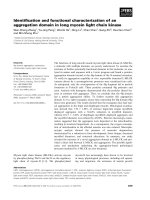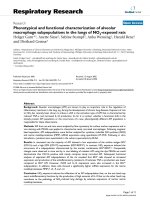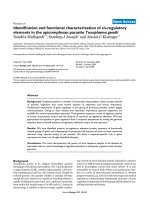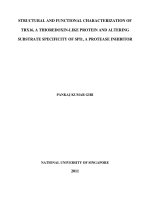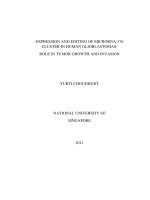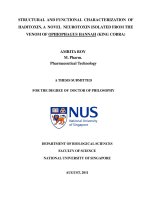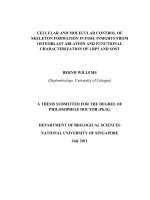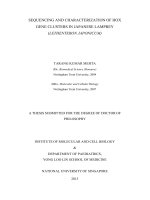Biochemical identification and functional characterization of microrna target interactions in growth control and cancer transformation
Bạn đang xem bản rút gọn của tài liệu. Xem và tải ngay bản đầy đủ của tài liệu tại đây (12.15 MB, 141 trang )
!
"!
BIOCHEMICAL IDENTIFICATION AND FUNCTIONAL CHARACTERIZATION
OF MICRORNA-TARGET INTERACTIONS IN GROWTH CONTROL AND
CANCER TRANSFORMATION
HONG XIN
(B.Sc. (Hons.), NUS
A THESIS SUBMITTED
FOR THE DEGREE OF DOCTOR OF PHILOSOPHY
INSTITUTE OF MOLECULAR AND CELL BIOLOGY
NATIONAL UNIVERSITY OF SINGAPORE
2013
!
""!
DECLARATION
I hereby declare that the thesis is my original work and it has been written by me in its
entirety. I have duly acknowledged all the sources of information which have been
used in the thesis. This thesis has also not been submitted for any degree in any
university previously.
_____________
Hong Xin
4th March 2013
!
"""!
ACKNOWLEDGEMENTS
I am deeply grateful to my PhD mentor, Professor Stephen Michel Cohen, for his
rigorous PhD training, great vision on science and directionality of projects. His broad
scope of scientific interests, inspiring ideas, critical thinking, deep penetrance of
scientific investigations and many other outstanding scientific qualities have been so
much beneficial throughout my PhD and will continuously be influential on my future
career. I would like to thank my thesis committee members, Professor Ng Huck Hui,
Dr #$%&! '(! )*++,+-, and Professor Toshie Kai for their valuable comments and
constructive advice.
My sincere thanks to all the past and current members of the Cohen lab, especially Dr
Thomas Sandman, Ms Lim Sing fee, Dr Jishy Varghese, Dr Chen Yawen, Dr Zhang
Wei and Dr Ge Wanzhong for creating a nice working environment, providing
numerous kind help whenever needed, and teaching me how to be a good scientists
during daily communications. I would like to express my heartfelt appreciation to my
collaborators Dr Molly Hammell, Mr Nguyen Thanh Hung, Dr Zhang Rui, Dr Mathijs
Voorhoeve, and Dr Hector Herranz. Without them, my PhD projects would not be
accomplished so smoothly. Thanks also go to Dr Wang Songyu, Vinayaka, Na Chen,
Dr Wang Xin Gang for the friendships.
Last but not least, I dedicated this thesis to my beloved wife JingJing, my parents, and
my son Xavier and my daughter-to-be-born for their love, support, and encouragement
throughout my PhD. They have been always one huge motivation in my scientific
career.
!
".!
TABLE OF CONTENT
!
SUMMARY' 'VI!
LIST'OF'TABLES' 'VIII!
LIST'OF'FIGURES' 'IX !
LIST'OF'SYMBOLS'AND'ABBREVIATIONS' 'XI!
LIST'OF'PUBLICATIONS' 'XII!
CHAPTER'1'INTRODUCTION' '1!
1.1! THE DISCOVERY OF ANIMAL MICRORNAS!((((((((((((((((((((((((((((((((((((((((((((((((((((((((((((((((((((((((((((((((((((!/!
1.2! MICRORNA BIOGENESIS!((((((((((((((((((((((((((((((((((((((((((((((((((((((((((((((((((((((((((((((((((((((((((((((((((((((((((((((((((((((!0!
1.2.1! microRNA transcription! !2!
1.2.2! miRNA maturation! !2!
1.2.3! RISC effector loading! !3!
1.2.4! Argonaute proteins as RISC effectors! !3!
1.3! MECHANISMS OF MIRNA ACTION!((((((((((((((((((((((((((((((((((((((((((((((((((((((((((((((((((((((((((((((((((((((((((((((((((((!1!
1.3.1! Mechanism of miRNA action! !4!
1.3.2! Effects on target mRNA level! !5!
1.3.2.1! Direct mRNA cleavage!((((((((((((((((((((((((((((((((((((((((((((((((((((((((((((((((((((((((((((((((((((((((((((((((((((((((((((((((((((((((((((((((((((((((((!2!
1.3.2.2! Repression by mRNA destabilization!(((((((((((((((((((((((((((((((((((((((((((((((((((((((((((((((((((((((((((((((((((((((((((((((((((((((((((((((!2!
1.3.3! Effect on protein translation! !7!
1.4 IDENTIFICATION AND VALIDATION OF MIRNA TARGETS!(((((((((((((((((((((((((((((((((((((((((((((((((((((((((((((!3!
1.4.1 Identification of miRNA targets! !8!
1.4.1.1 Computational prediction!((((((((((((((((((((((((((((((((((((((((((((((((((((((((((((((((((((((((((((((((((((((((((((((((((((((((((((((((((((((((((((((((((((((((((!3!
1.4.1.2 Target identification based on genome-wide expression profiling!(((((((((((((((((((((((((((((((( ((((((((((((((((((((((((((((!//!
1.4.1.3 Biochemical purification of miRNP complex coupled to high throughput platforms!(((((((((((((((((((((((((!/4!
1.4.2 Experimental validation of microRNA targets! !15!
1.4.2.1 Target reporter assay in vitro and in vivo!((((((((((((((((((((((((((((((((((((((((((((((((((((((((((((((((((((((((((((((((((((((((((((((((((((((((((!/2!
1.4.2.2 Measuring target level in microRNA overexpressed and/or depleted cells!(((((((((((((((((((((((((((((((((((((((((((!/5!
1.4.2.3 Genetic and functional interactions between a microRNA and its targets!(((((((((((((((((((((((((((((((((((((((((((((!/3!
1.5! GENETIC MANIPULATIONS OF MIRNA ACTIVITIES IN CELLS AND ORGANISMS!(((((((((((((!/6!
1.5.1 Genetic knockouts!((((((((((((((((((((((((((((((((((((((((((((((((((((((((((((((((((((((((((((((((((((((((((((((((((((((((((((((((((((((((((((((((((((((((((((((((((((((((((!/6!
1.5.2 Application of miRNA sponges!((((((((((((((((((((((((((((((((((((((((((((((((((((((((((((((((((((((((((((((((((((((((((((((((((((((((((((((((((((((((((((((((!0/!
1.6 MIRNA DYSREGULATION IN CANCER CELLS!(((((((((((((((((((((((((((((((((((((((((((((((((((((((((((((((((((((((((((((((((!04!
1.6.1 Genomic copy number alterations of miRNAs in cancer! !24!
1.6.2 Change in transcriptional regulations of miRNAs in cancer! !25!
1.6.3 miRNAs dysregulate many downstream signaling pathways critically involved in
cancer initiation and progression! !25!
CHAPTER'2'MATERIALS'AND'METHODS' '33!
2.1 DROSOPHILAGENETICS!(((((((((((((((((((((((((((((((((((((((((((((((((((((((((((((((((((((((((((((((((((((((((((((((((((((((((((((((((((((((((!44!
2.2 IMMUNOSTAINING!((((((((((((((((((((((((((((((((((((((((((((((((((((((((((((((((((((((((((((((((((((((((((((((((((((((((((((((((((((((((((((((((((!44!
2.3 SDS-PAGE AND IMMUNOBLOT ANALYSIS!((((((((((((((((((((((((((((((((((((((((((((((((((((((((((((((((((((((((((((((((((((!41!
2.4 IMMUNOPURIFICATION OF MIRNP COMPLEX FROM DROSOPHILAS2 CELLS!((((((((((((((((((((((!41!
2.5 UTR REPORTER CONSTRUCTS AND LUCIFERASE REPORTER ASSAYS!((((((((((((((((((((((((((((((((((((!42!
2.6 MIRNA AND MRNA QUANTITATIVE REAL TIME PCR!((((((((((((((((((((((((((((((((((((((((((((((((((((((((((((((((!47!
2.7 EXPRESSION PROFILING!((((((((((((((((((((((((((((((((((((((((((((((((((((((((((((((((((((((((((((((((((((((((((((((((((((((((((((((((((((((((!45!
2.8 MIRNA TARGET SITE PREDICTION!(((((((((((((((((((((((((((((((((((((((((((((((((((((((((((((((((((((((((((((((((((((((((((((((((((!43!
2.9 STATISTICAL ANALYSIS!((((((((((((((((((((((((((((((((((((((((((((((((((((((((((((((((((((((((((((((((((((((((((((((((((((((((((((((((((((((((!46!
2.10 MAMMALIAN CELL CULTURE!(((((((((((((((((((((((((((((((((((((((((((((((((((((((((((((((((((((((((((((((((((((((((((((((((((((((((((!46!
2.11 SOFT AGAR COLONY FORMATION ASSAY!(((((((((((((((((((((((((((((((((((((((((((((((((((((((((((((((((((((((((((((((((((((!18!
2.12 CANCER PATIENT SURVIVAL ANALYSIS!((((((((((((((((((((((((((((((((((((((((((((((((((((((((((((((((((((((((((((((((((((((((!18!
!
.!
CHAPTER'3'BIOCHEMICAL'PURIFICATION'OF'MIRNA;RISC'COMPLEX'COUPLED'TO'
HIGH;THROUGHPUT'MICROARRAY'PROFILING'IDENTIFIES'A'DISTINCT'SET'OF'
MIRNA'TARGETS'IN'DROSOPHILAS2'CELLS' '41!
3.1 INTRODUCTION!((((((((((((((((((((((((((((((((((((((((((((((((((((((((((((((((((((((((((((((((((((((((((((((((((((((((((((((((((((((((((((((((((((((((!1/!
3.2 EXPERIMENTAL ASSESSMENT OF AN IMPROVED AGO1 IMMUNOPURIFICATION PROTOCOL
!((((((((((((((((((((((((((((((((((((((((((((((((((((((((((((((((((((((((((((((((((((((((((((((((((((((((((((((((((((((((((((((((((((((((((((((((((((((((((((((((((((((((((((((!14!
3.3 EXPRESSION PROFILING OF MRNAS ASSOCIATED WITH AGO1 IDENTIFIED HUNDREDS OF
IP-ENRICHED TRANSCRIPTS!((((((((((((((((((((((((((((((((((((((((((((((((((((((((((((((((((((((((((((((((((((((((((((((((((((((((((((((((((((((((!17!
3.4 EXPERIMENTAL VALIDATION OF TARGET ENRICHMENT IN AGO1 IP!((((((((((((((((((((((((((((((((((((!28!
3.5 EXPERIMENTAL VALIDATION OF SELECTED MIR-184 TARGETS IDENTIFIED BY AGO1 IP
!((((((((((((((((((((((((((((((((((((((((((((((((((((((((((((((((((((((((((((((((((((((((((((((((((((((((((((((((((((((((((((((((((((((((((((((((((((((((((((((((((((((((((((((!22!
3.6 SEED TYPE ENRICHMENT OF THE TARGET SITES IN AGO1 IP-ENRICHED TRANSCRIPTS!((!78!
3.7 OTHER CONTEXTUAL FEATURES ENRICHED IN AGO1 IP-ENRICHED TRANSCRIPTS!((((((((((!7/!
3.8. COMPARISON OF TARGETS IDENTIFIED BY AGO1 IP AND AGO1 DEPLETION!(((((((((((((((((((((!75!
3.9 FUNCTIONAL CLUSTERING SUGGESTS DISTINCT BIOLOGICAL FUNCTIONS IN THE TWO
TARGET GROUPS!(((((((((((((((((((((((((((((((((((((((((((((((((((((((((((((((((((((((((((((((((((((((((((((((((((((((((((((((((((((((((((((((((((((((((((((!53!
3.10. GENOME-WIDE ANALYSIS SHOWS MIRNA TARGETS WITH DISTINCT STRUCTURAL AND
MOLECULAR PROPERTIES!((((((((((((((((((((((((((((((((((((((((((((((((((((((((((((((((((((((((((((((((((((((((((((((((((((((((((((((((((((((((((((!38!
3.11 DISCUSSION!((((((((((((((((((((((((((((((((((((((((((((((((((((((((((((((((((((((((((((((((((((((((((((((((((((((((((((((((((((((((((((((((((((((((((((!34!
CHAPTER'4'FUNCTIONAL'CHARACTERIZATION'OF'BANTAM;SOCS36 E'IN TE R A CT IO N '
LEADS'TO'IDENTIFICATION'OF'S O CS 'PR O T E IN 'FAMILIES'AS'ONCOGENIC'
COOPERATING'FACTORS'IN'EGFR/ R A S
V12
;DRIVEN'TUMORIGENESIS' '86!
4.1 INTRODUCTION!((((((((((((((((((((((((((((((((((((((((((((((((((((((((((((((((((((((((((((((((((((((((((((((((((((((((((((((((((((((((((((((((((((((((!37!
4.2 DEPLETION OF BANTAM BY MICRORNA SPONGE PRODUCES EGFR-LIKE PHENOTYPES!((!33!
4.3 IDENTIFICATION OF SOCS36E AS A BANTAM TARGET!((((((((((((((((((((((((((((((((((((((((((((((((((((((((((((((((((!6/!
4.4 SOCS36E IS A NEGATIVE GROWTH REGULATOR.!((((((((((((((((((((((((((((((((((((((((((((((((((((((((((((((((((((((((((!61!
4.5 SOCS36E IS A NEGATIVE FEEDBACK REGULATOR OF EGFR SIGNALING!((((((((((((((((((((((((((((((!65!
4.6 SOCS36E BEHAVES AS A TUMOR SUPPRESSOR UNDER CONDITIONS OF ELEVATED EGFR
ACTIVITY!((((((((((((((((((((((((((((((((((((((((((((((((((((((((((((((((((((((((((((((((((((((((((((((((((((((((((((((((((((((((((((((((((((((((((((((((((((((((!/88!
4.7 HUMAN SOCS5 BEHAVES AS A CANDIDATE TUMOR SUPPRESSOR IN AN EGFR/RAS-
DEPENDENT CELLULAR TRANSFORMATION ASSAY!((((((((((((((((((((((((((((((((((((((((((((((((((((((((((((((((((((((((((!/84!
4.8 SOCS5 EXPRESSION IS DOWNREGULATED IN BREAST CANCER AND ASSOCIATED WITH
METASTATIC-FREE SURVIVAL!(((((((((((((((((((((((((((((((((((((((((((((((((((((((((((((((((((((((((((((((((((((((((((((((((((((((((((((((((!/87!
4.9 DISCUSSION!(((((((((((((((((((((((((((((((((((((((((((((((((((((((((((((((((((((((((((((((((((((((((((((((((((((((((((((((((((((((((((((((((((((((((((!//8!
CHAPTER'5'CONCLUSION'AND'FUTURE'WORK' .'114!
!
!
!
!
!
!
."!
SUMMARY
microRNAs are a class of non-coding RNAs of 21 to 23 nucleotides in length. They
are endogenously expressed in the majority of eukaryotes. MicroRNAs form protein-
RNA complexes with the RNA-induced silencing complex (RISC) and bind to either
3’UTR or coding regions of messenger RNAs, causing destabilization of mRNA
and/or inhibition of protein translation. Animal microRNAs recognize their mRNA
target via imperfect base pairing. The 5’ position from 2-8nt, the so called “seed
region”, is critical for microRNAs to repress their targets. Each miRNA is predicted to
regulate up to hundreds of genes and more than 65% of the animal genome could be
potentially targeted by miRNAs. miRNAs play important roles in diverse biological
processes, including growth, differentiation, neurogenesis, apoptosis and metabolism.
Misregulation of miRNAs is correlated with various types of human pathologies
including cancer and directly contribute to disease initiation and progression
(representative reviews in (Iorio and Croce, 2012; Mendell and Olson, 2012; Rottiers
and Naar, 2012)).
My PhD project is focused on identification and functional characterizations of
miRNA-target interactions involved in growth control and cancer transformation. I
used biochemical immunoprecipitation against Drosophila Ago1 (Ago1-IP) to isolate
and purify Ago1/miRNA/mRNA complex and utilized microarray profiling to identify
mRNAs enriched in Ago1-IP in Drosophila S2 cells. Hundreds of potential miRNA
targets associated with Ago1 in Drosophila S2 cells were identified by Ago1-IP.
Computational analysis using the IP-enriched target sets and Ago1 RNAi-upregulated
target sets suggested the existence of two distinct sets of microRNA targets that exhibit
substantial differences in molecular and structural properties. My study further
!
.""!
revealed a genome-wide correlation between binding site accessibility and the 3’UTR
length of mRNA targets, suggesting an unprecedented complexity of miRNA-target
interactions.
One target that I identified from the Ago1-IP is Socs36E, which contains a binding site
for the growth regulatory microRNA, bantam. Genetic and functional analysis
suggested Socs36E is a negative growth regulator and contributes to bantam’s loss-of-
function phenotype in the Drosophila wing. Mechanistically, Socs36E negatively
regulates EGFR activity while EGFR signaling also controls Socs36E expression,
forming a negative feedback regulatory loop. Socs36E acts as a “brake” to repress
excessive EGFR signaling and when the “brake” is removed, EGFR overexpression
leads to uncontrolled tumorous overgrowth and neoplastic transformation. Using an in
vitro cancer transformation model of primary human fibroblast cells, I further
demonstrated one of the human orthologs of Socs36E, SOCS5, is a potential
cooperating tumor suppressor of Ras
V12
/EGF-driven cancer transformation. SOCS5 is
downregulated in breast cancer samples and associated with ErBB/ER/PR status.
Lower SOCS5 expression correlates with poorer metastatic-free survival in breast
cancer patients, suggesting SOCS5 can be a potential biomarker with prognostic value.
Taken together, through characterization of miRNA-target interactions involved in
developmental growth control, my collaborators and I have identified the SOCS
protein family, as oncogenic cooperation factors of EGFR/Ras/MAPK- mediated
cancer transformation in both Drosophila and human.
!
!
!
!
!
!
."""!
LIST OF TABLES
9:;<,!/(!/!=!>$?@:A*%$+!$B!C*BB,A,+D!>$?@ED:D*$+:<!@A,C*>D*$+!@A$FA:?%!((((((((((((((((((((((((((((((((((((((((((((((((!40!
!
9:;<,!4(!/!G*%D!$B!?*>A$'H=!%,,C!B:?*<*,%!,I@A,%%,C!*+!)A$%$*@J*<:!K0!>,<<%(!(((((((((((((((((((((((((((((((((((((((((((!28!
!
9:;<,!4(!0!9J,!+$+LA,CE+C:+D!%,D!$B!M:<*C:D,C!?*'H =!D:AF,D!@: *A%(!(((((((((((((((((((((((((((((((((((((((((((((((((((((((((((((!21!
!
9:;<,!4(!4!NA,C*>D,C!?*'L/31!D:AF,D%!,+A*>J,C!*+!=F$/!"N(!(((((((((((((((((((((((((((((((((((((((((((((((((((((((((((((((((((((((((((((((!23!
!
9:;<,!4(!1!!KE??:A-!$B!"N!D:AF,D!M:<*C:D*$+(!((((((((((((((((((((((((((((((((((((((((((((((((((((((((((((((((((((((((((((((((((((((((((((((((((((((((((((!26!
!
9:;<,!4(!2!=+:<-%*%!$B!,+A*>J?,+D!B$A!%D:;<,!J-;A*C*O:D*$+!;*+C*+F!,+,AF-P!QRSP!TU
J-;A*C(
!(((((((((((((((((!71!
!
9:;<,!4(!7!=+:<-%*%!$B!,+A*>J?,+D!B$A!?*'H=!;*+C*+F!%*D,!$@,++,%%!B$A!"NL,+A*>J,C!DA:%>A*@D%!
E%*+F!+$+L"N!,+A*>J,C!DA:+%>A*@D%!((((((((((((((((((((((((((((((((((((((((((((((((((((((((((((((((((((((((((((((((((((((((((((((((((((((((((((((((((((!71!
!
9:;<,!4(!5!=+:<-%*%!$B!,+A*>J?,+D!B$A!?*'H=!;*+ C *+F !%*D, !$ @, + + ,% %!B$A !"NL,+ A*>J,C!DA:+%>A*@D%!
E%*+F!:<<!K0!>,<<%!DA:+%>A*@D%!:%!>$+DA$<%!(((((((((((((((((((((((((((((((((((((((((((((((((((((((((((((((((((((((((((((((((((((((((((((((((((((((((!72!
!
9:;<,!4(!3!!=+:<-%*%!$B!?*'H=!;*+C*+F!%*D,!$@,++,%%!:+C!B<:+V*+ F!A ,F *$+ !$ @ ,+ + , %%!*+ != F $/ !"NL
,+A*>J,C!FA$E@(!(((((((((((((((((((((((((((((((((((((((((((((((((((((((((((((((((((((((((((((((((((((((((((((((((((((((((((((((((((((((((((((((((((((((((((((((((((((((((!77!
!
9:;<,!4(!6!=+:<-%*%!$B!,+A*>J?,+D!B$A!%D:;<,!J-;A*C*O:D*$+!;*+C*+F!,+,AF-!WQRSX!*+!=F$/!'H=*L
E@A,FE<:D,C!FA$E@(!((((((((((((((((((((((((((((((((((((((((((((((((((((((((((((((((((((((((((((((((((((((((((((((((((((((((((((((((((((((((((((((((((((((((((((((((((!54!
!
9:;<,!4(!/8!=+:<-%*%!$B!,+A*>J?,+D!B$A!?*'H=!;*+C*+F!%*D,!$@,++,%%!B$A!=F$/!'H=*LE@A,FE<:D,C!
DA:+%>A*@D%!:%!>$?@:A, C!D$!:<<!C,D,> D:;<,!K0 !>,<<!DA:+%>A*@ D%!(((((((((((((((((((((((((((((((((((((((((((((((((((((((((((((((!57!
!
9:;<,!4(!//!=+:<-%*%!$B!?*'H=!;*+C*+F!%*D,!$@,++,%%!:+C!B<:+V*+F!A,F*$+!$@,++,%%!*+!=F$/!'H=*!
E@A,FE<:D,C!FA$E@(!((((((((((((((((((((((((((((((((((((((((((((((((((((((((((((((((((((((((((((((((((((((((((((((((((((((((((((((((((((((((((((((((((((((((((((((((((!53!
!
9:;<,!4(!/0!U,+,!$+D$<$F-!:+:<-%*%!$B!=F$/!"NL,+A*>J,C!DA:+%>A*@D%!:+C!DA:+%>A*@D%!E@A,FE<:D,C!;-!
=F$/!'H=*(!(((((((((((((((((((((((((((((((((((((((((((((((((((((((((((((((((((((((((((((((((((((((((((((((((((((((((((((((((((((((((((((((((((((((((((((((((((((((((((((((((((!56!
!
9:;<,!4(!/4!U,+$?,LY*C,!>$?@:A*%$+%!$B!E@%DA,:?P!C$Y+%DA,:?P!:+C!%*D,!$@,++,%%!
W:>>,%%*;*<*D-X!$B!:<<!@A,C*>D,C!?*'H =!%*D,%!:%!:!BE+ >D*$+!$B!Z 9' !<,+FDJ (!((((((((((((((((((((((((((((((((((((((((!34!
!
9:;<,!1(!/!!G*%D*+F!$B!G$F0!?,C*:+L>,+D,A,C!K[\K2!,I@A,%%*$+!<,M,<%!B$A!,:>J!*+C*>:D,C!C:D:%,D(
!(((((((((((((((((((((((((((((((((((((((((((((((((((((((((((((((((((((((((((((((((((((((((((((((((((((((((((((((((((((((((((((((((((((((((((((((((((((((((((((((((((((((((((((((((((((((!//8!
!
!
!
!
"]!
LIST OF FIGURES
R*FEA,!/(!/!?*>A$'H=!;*$F,+,%*%!:+C!:>D*$+!(((((((((((((((((((((((((((((((((((((((((((((((((((((((((((((((((((((((((((((((((((((((((((((((((((((((((((!05!
!
R*FEA,!/(!0!=AF$+:ED,!C$?:*+!$AF:+*O:D*$+!(((((((((((((((((((((((((((((((((((((((((((((((((((((((((((((((((((((((((((((((((((((((((((((((((((((((((((((!03!
!
R*FEA,!/(!4!=F$^U_/30!:%!,BB,>D$A!>$?@<,I!*+!?*'H=L?,C*:D,C!F,+,!%*<,+>*+F(!((((((((((((((((((((((((((((((((((!03!
!
R*FEA,!/(!2!K>J,?:D*>!A,@A,%,+D:D*$+!$B!,+C%L$ED!F,+,!D:AF,D*+F!;-!J$?$<$F$E%!A,>$?;*+:D*$+!(!48!
!
R*FEA,!/(!7!?*'H=!%@$+F,!C,%*F+!(((((((((((((((((((((((((((((((((((((((((((((((((((((((((((((((((((((((((((((((((((((((((((((((((((((((((((((((((((((((((((((((((!4/!
!
R*FEA,!/(!5!9J,!F,+,A:<!Y$AVB<$Y!B$A!%?:<<!'H=!%,`E,+>*+F!;-!HUK!@<:DB$A?%!((((!ERROR!'B OOKMARK'
NOT'DEFINED.!
!
R*FEA,!4(!/!9J,!F,+,A:<!Y$AVB<$Y!$B!:+!*?@A$M,C!=F$/!*??E+$@EA*B*>:D*$+!@A$D$>$<(!((((((((((((((((((((((!12!
!
R*FEA,!4(!0!=!A,@A,%,+D:D*M,!*??E+$;<$D!$B!=F$/!"N!$+!DA:+%F,+*>!K0!>,<<%!,I@A,%%*+F!:!R<:F^a=!
,@*D$@,!D:FF,C!=F$/!WbX!$A!>$+DA$<!K0!>,<<%!WLX(!((((((((((((((((((((((((((((((((((((((((((((((((((((((((((((((((((((((((((((((((((((((((((!17!
!
R*FEA,!4(!4!?*'H=%!:+C!M:<*C:D,C!V+$Y+!D:AF,D%!:A,!,+A*>J,C!*+!=F$/!*??E+$@EA*B*,C!'H=!
>$?@<,I!(((((((((((((((((((((((((((((((((((((((((((((((((((((((((((((((((((((((((((((((((((((((((((((((((((((((((((((((((((((((((((((((((((((((((((((((((((((((((((((((((((((((((!17!
!
R*FEA,!4(!1!HE?;,A!$B!DA:+%>A*@D%!,+A*>J,C!*+!=F$/!"N!:+C!DJ,!?,:+!:;E+C:+>,!$B!DA:+%>A*@D%(!(((!13!
!
R*FEA,!4(!2!.:<*C:D*$+!$B!%,<,>D,C!"NL,+A*>J,C!F,+,%!;-!*+C,@,+C,+D!"NLcLN\'(!((((((((((((((((((((((((((((((((((((!16!
!
R*FEA,!4(!7!\$?@:A*%$+!$B!"N!A,%E<D%!Y*DJ!,I@,A*?,+D:<<-!M:<*C:D,C!?*'H=!D:AF,D%(!((((((((((((((((((((((((((((!20!
!
R*FEA,!4(!5!SBB,>D!$B!?*'L/31!C,@<,D*$+!$+!DJ,!A,>$M,A-!$B!@A,C*>D,C!?*AL/31!D:AF,D%!;-!"N(!(((((((((((!24!
!
!
R*FEA,!4(!3!SBB,>D!$B!?*'L/31!C,@<,D*$+!$+!DJ,!,I@A,%%*$+!<,M,<!$B!?*AL/31!D:AF,D%!B$A!"NL,+A*>J,C!
.%!+$+!"NL,+A*>J,C!%,D%(!((((((((((((((((((((((((((((((((((((((((((((((((((((((((((((((((((((((((((((((((((((((((((((((((((((((((((((((((((((((((((((((((((((((((!27!
!
R*FEA,!4(!6!GE>*B,A:%,!:%%:-!M:<*C:D*$+!$+!%,<,>D,C!"NL,+A*>J,C!?*AL/31!D:AF,D%(!((((((((((((((((((((((((((((((((((!25!
!
R*FEA,!4(!/8!?*'H=!D:AF,D!%,,C!D-@,!,+A*>J?,+D!:+:<-%*%!*+!=F$/!"NL,+A*>J,C!DA:+%>A*@D%(!((((((((((((!7/!
!
R*FEA,!4(!//!UA:@J*>!A,@A,%,+D:D*$+!$B!?*'H=!;*+C*+F!%*D,!$@,++,%%!:+C!B<:+V*+F!A,F*$+!$@,++,%%!
:%!%J$Y+!*+!9:;<,!4(3(!((((((((((((((((((((((((((((((((((((((((((((((((((((((((((((((((((((((((((((((((((((((((((((((((((((((((((((((((((((((((((((((((((((((((((((!75!
!
R*FEA,!4(!/0!=!>$?@:A:D*M,!:+:<-%*%!$+!=F$/!"NL,+A*>J,C!DA:+%>A*@D%!.%!=F$/!'H=*LE@A,FE<:D,C!
DA:+%>A*@D%(!((((((((((((((((((((((((((((((((((((((((((((((((((((((((((((((((((((((((((((((((((((((((((((((((((((((((((((((((((((((((((((((((((((((((((((((((((((((((((((((((((!58!
!
R*FEA,!4(!/4!\$?@:A*%$+!$B!%,,C!D-@,!,+A*>J?,+D!$B!D:AF,D%!*C,+D*B*,C!;-!=F$/!"N!:+C!=F $/ !
C,@<,D*$+(!(((((((((((((((((((((((((((((((((((((((((((((((((((((((((((((((((((((((((((((((((((((((((((((((((((((((((((((((((((((((((((((((((((((((((((((((((((((((((((((((((((((!5/!
!
R*FEA,!4(!/1!\$?@:A*%$+!$B!;*+C*+F!%*D,!,+,AF-!$B!D:AF,D%!*C,+D*B*,C!;-!=F$/!"N!:+C!=F$/!
C,@<,D*$+(!(((((((((((((((((((((((((((((((((((((((((((((((((((((((((((((((((((((((((((((((((((((((((((((((((((((((((((((((((((((((((((((((((((((((((((((((((((((((((((((((((((((!50!
!
R*FEA,!4(!/2!!)*BB,A,+>,%!*+!Z9'!<,+FDJ!:+C!?*'H=!%*D,!C,+%*D-!C*%DA*;ED*$+%!;,DY,,+!=F$/!"NL
,+A*>J,C!FA$E@!:+C!=F$/!'H=*LE@A,FE<:D,C!FA$E@(!((((((((((((((((((((((((((((((((((((((((((((((((((((((((((((((((((((((((((((((((!51!
!
!
]!
R*FEA,!4(!/7!=%%,%%?,+D!$B!?*'H=!%*D,!$@,++,%%P!E@%DA,:?!$@,++,%%!:+C!C$Y+%DA,:?!$@,++,%%!
B$A!DJ,!=F$ /!' H = *!E @ A, FE <: D, C!% ,D!M %!: <<!K0 !' H = %!Y *DJ !%*D ,%(!((((((((((((((((((((((((((((((((((((((((((((((((((((((((((((((!52!
!
R*FEA,!4(!/5!R$<C!,+A*>J?,+D!B$A!DJ,!$@D*?:<!E@%DA,:?!Y*+C$Y%!W42+DX!:+C!C$Y+%DA,:?!
Y*+C$Y%!W28+DX!*+!"NL,+A*>J,C!:+C!=F$/!'H=*!E@A,FE<:D,C!%,D%(!(((((((((((((((((((((((((((((((((((((((((((((((((((((!55!
!
R*FEA,!4(!/3!Z9'!<,+FDJ!M,A%E%!%*D,!C,+%*D-!:+C!%DAE>DEA:<!$@,++,%%!*+!)A$%$@J*<:?'H=%(!((((((((((((!30!
!
R*FEA,!1(!/!bantam!?*>A$'H=!%@$+F,!C,%*F+!:+C!M:<*C:D*$+!(((((((((((((((((((((((((((((((((((((((((((((((((((((((((((((((((((((((((((!68!
!
R*FEA,!1(!0!bantam!C,@<,D*$+!;-!?*>A$'H=!%@$+F,!A,%,?;<,C!DJ,!,BB,>D!$B!SUR'!C,@<,D*$+!*+!DJ,!
Y*+F!((((((((((((((((((((((((((((((((((((((((((((((((((((((((((((((((((((((((((((((((((((((((((((((((((((((((((((((((((((((((((((((((((((((((((((((((((((((((((((((((((((((((((((((((!6/!
!
R*FEA,!1(!4!Socs36E!*%!:!C*A, > D!bantam !D:AF, D!((((((((((((((((((((((((((((((((((((((((((((((((((((((((((((((((((((((((((((((((((((((((((((((((((((((((((!64!
!
R*FEA,!1(!1!bantam!A,FE<:D, %!Socs36E!<,M, <!*+!M *M$ !(((((((((((((((((((((((((((((((((((((((((((((((((((((((((((((((((((((((((((((((((((((((((((((((!61!
!
R*FEA,!1(!2!Socs36E!?ED:+D!B<*,%!:A,!%<*FJD<-!;*FF,A!*+!%*O,!(((((((((((((((((((((((((((((((((((((((((((((((((((((((((((((((((((((((((((((((!67!
!
R*FEA,!1(!7!Socs36E!*%!:!+, F :D *M, !F A$ Y D J !A,F E <: D$ A! DJ: D!F,+, D*>:<<-!*+D,A:>D%!Y *DJ!bantam !((((((((((((((!65!
!
R*FEA,!1(!5!Socs36E!A,@A,%%,%!SUR '^ Q =Nd !%*F+:<*+F !(((((((((((((((((((((((((((((((((((((((((((((((((((((((((((((((((((((((((((((((((((((((((!63!
!
R*FEA,!1(!3!SUR'!:<%$!A,FE<:D,%!Socs36E!,I@A,%%*$+P!DJE%!B$A?*+F!:!+,F:D*M,!B,,C;:>V!<$$@(!((((((((((!66!
!
R*FEA,!1(!6!),@<,D*$+!$B!Socs36E!*+!SUR'!$M , A,I @ A ,%% *+ F !Y *+ F !C*% >% !>: E %, C!C A: ?:D*>!D*%%E,!
$M,AFA$Y+!((((((((((((((((((((((((((((((((((((((((((((((((((((((((((((((((((((((((((((((((((((((((((((((((((((((((((((((((((((((((((((((((((((((((((((((((((((((((((((((((!/80!
!
R*FEA,!1(!/8!),@<,D*$+!$B!Soce36E!*+!SUR'!$M,A,I@A,%%*+ F !Y*+F!<,:C!D$!+,$ @ <: %D *>!DA : + %B$ A?:D*$+
!(((((((((((((((((((((((((((((((((((((((((((((((((((((((((((((((((((((((((((((((((((((((((((((((((((((((((((((((((((((((((((((((((((((((((((((((((((((((((((((((((((((((((((((((((((((((!/84!
!
R*FEA,!1(!//!),@<,D*$+!$B!K[\K2!,+J:+>,C!%$BD!:F:A!>$<$+-!B$A?:D*$+!*+!@A*?:A-!JE?:+!B*;A$;<:%D!
>,<<%!((((((((((((((((((((((((((((((((((((((((((((((((((((((((((((((((((((((((((((((((((((((((((((((((((((((((((((((((((((((((((((((((((((((((((((((((((((((((((((((((((((((((((((((!/82!
!
R*FEA,!1(!/0!K[\K2!?ED:D*$+!A:D,%!:+C!?'H=!,I@A,%%*$+!*+!>:+>,A!(((((((((((((((((((((((((((((((((((((((((((((((((((((((((!/83!
!
R*FEA,!1(!/4!K[\K2!,I@A,%%*$+!*%!:%%$>*:D,C!Y*DJ!?,D:%D:D*>LBA,,!%EAM*M:<!*+ !; A, :% D!>:+>,A!@:D*,+D%
!(((((((((((((((((((((((((((((((((((((((((((((((((((((((((((((((((((((((((((((((((((((((((((((((((((((((((((((((((((((((((((((((((((((((((((((((((((((((((((((((((((((((((((((((((((((((!/86!
!
!
]"!
LIST OF SYMBOLS AND ABBREVIATIONS
Ago argonaute
AUBPs adenine/uridine-rich element binding proteins
CTD C-terminal domain
DTT Dithiothreitol
EGFR epidermal growth factor receptor
GO gene ontology
GPCR G-protein-coupled receptor
Hsp70 70 kDa heat-shock protein
Ig Immunoglobulin
IP immunopurification
JAK-STAT The janus kinase - signal transducer and activator of transcription
MAPK Mitogen Activated Protein Kinase
miRNP microRNA associated ribonucleoprotein complexes
mir-Q microRNA quantitative real time PCR
PI(3)P lipid phosphatidylinositol 3-phosphate
RT Room temperature
RTK Receptor tyrosine kinase
RISC RNA induced silencing complex
Socs suppressors of cytokine signaling
SD Standard deviation
UTR untranslated region
!
!
]""!
LIST OF PUBLICATIONS
Héctor Herranz *, Xin Hong *, Nguyen Thanh Hung, P. Mathijs Voorhoeve and
Stephen M Cohen. Oncogenic cooperation between SOCS family proteins and EGFR
identified using Drosophila transformation model. Genes & Development,
15;26(14):1602-11 (2012). (* equal contribution)
Héctor Herranz, Xin Hong, Stephen M. Cohen. Mutual Repression by bantam miRNA
and Capicua Links the EGFR/MAPK and Hippo Pathways in Growth Control. Current
Biology 22, 651–657 (2012).
Isabelle Becam, Neus Rafel, Xin Hong, Stephen M Cohen and Marco Milán. Notch-
mediated repression of bantam miRNA contributes to boundary formation in the
Drosophila wing. Development 138, 3781-3789 (2011).
Hector Herranz, Xin Hong, Lidia Perez, Ana Ferreira, Daniel Olivieri, Stephen M
Cohen and Marco Milan. The miRNA machinery targets Mei-P26 and regulates Myc
protein levels in the Drosophila wing. The EMBO Journal (2010) 29, 1688–1698.
Xin Hong*, Molly Hammell*, Victor Ambros, and Stephen M Cohen.
Immunopurification of Ago1 miRNPs selects for a distinct class of microRNA targets.
PNAS 106 (35) 15085–15090 (2009). ( * equal contribution)
!
/!
Chapter 1 Introduction
1.1 The discovery of animal microRNAs
microRNAs are emerging as an important class of post-transcriptional regulators
involved in diverse biological processes. These 21-23 nucleotides long, endogenously
expressed small RNAs, recruit RNA-induced silencing complex (RISC) and bind to
3’UTR as well as coding regions of messenger RNAs, which results in destabilization
of mRNA and/or inhibition of protein translation.
The first two animal microRNAs were discovered as heterochronic genes in C.
elegans. The heterochronic genes regulate timing of developmental transitions in the
nematode. One such heterochronic gene identified was lin-4. The C elegans lin-4 loss-
of-function mutant stayed in the first larval stage L1 without developing further (Lee et
al., 1993; Wightman et al., 1993). Furthermore, it was found the 3’untranslated region
of another heterochronic gene, lin-14, played a critical role to diminish lin-14 protein
level during developmental transition from L1 to L2 (Wightman et al., 1991).
Strikingly, lin-4 was found to be a small RNA of about 20-60 bp, that can repress lin-
14 post-transcriptionally via imperfect complementarity to the 3’UTR sequences of
lin-14. The repression of lin-14 by lin-4 does not involve any nearby known protein
coding sequences and this mode of regulation is functionally critical for the larvae to
undergo L1 to L2 transition (Lee et al., 1993; Wightman et al., 1993). Since then, more
and more such tiny regulatory RNAs, which represses their target mRNAs by direct
binding, are continuously being discovered as facilitated by the technological
advancement of next-generation sequencing (NGS). Thanks to NGS, many thousands
of miRNAs have been discovered in various species and the number is still growing.
Each miRNA is predicted to regulate up to hundreds of genes and majority of the
!
0!
animal genome could be potentially targeted by miRNAs. Hence, miRNAs represent a
new class of regulators with intriguing biological functions.
1.1.1 microRNA transcription
Like protein-coding genes, miRNAs are transcribed by RNA polymerase II (Pol II),
resulting in a long primary transcript with 5’ capped and 3’ polyadenylated (Lee et al.,
2004a). Most miRNAs are intergenic, but a significant fraction of them are located
within the introns of protein-coding genes. If a miRNA is intronic, it is presumably
transcribed together with the host gene and can be under the same promoter regulation
as the host. A few miRNAs occur as clusters in the genome and the whole cluster is
usually transcribed as a single primary transcripts.
1.1.2 miRNA maturation
The primary miRNA transcript is firstly processed by the “microprocessor” complex,
composed of RNase III enzyme Drosha and a dsRNA binding domain protein named
Pasha (partner of Drosha). The Drosha/Pasha complex cleaves the pri-miRNA
transcript into a ~60-70 nt stem loop precursor miRNA (pre-miRNA, (Allen et al.,
2004; Meister et al., 2004), leaving molecular signatures with a 5’ phosphate and an
~2nt 3’ overhang. The 3’ overhang of the pre-miRNA is recognized by Exportin-5, a
Ran-GTP dependent nuclear export factor, and exported to cytoplasm (Bohnsack et al.,
2004; Lund et al., 2004; Yi et al., 2003).
After cytoplasmic export, the pre-miRNA is further processed in the cytoplasm by
another RNaseIII enzyme called Dicer. Dicer recognizes the 3’ 2nt overhang of the
pre-miRNAs through its PAZ domain, cleaves the pre-miRNA to produce a mature
!
4!
~22mer miRNA/miRNA* duplex. The miRNA* (passenger strand) is usually
degraded rapidly and only the miRNA (leading strand) is predominantly expressed
(Aravin et al., 2003; Lagos-Quintana et al., 2002; Lau et al., 2001). Drosophila has
two Dicers, Dicer-1 for miRNA processing and Dicer-2 for endogenous siRNA
processing respectively. Dicer-1 binds to Loquacious (TRBP in humans), a dsRNA
binding protein, for efficient production of mature miRNAs from pre-miRNAs (Saito
et al., 2005; (Haase et al., 2005) and Dicer-2 forms a complex with R2D2, another
dsRNA binding protein responsible for production of siRNAs (Lee et al., 2004b; Liu et
al., 2003; Pham et al., 2004).
1.1.3 RISC effector loading
Once the miRNA duplex is formed, the miRNA strand will be preferentially loaded
into the multi-protein effector complexes called RISC (RNA-induced silencing
complex). The fact that purified Ago-miRNA complex mainly contain single-stranded
miRNA suggested a mechanism to unwind the duplex before loading into Ago
complex is required (Martinez et al., 2002). The loading preference on one strand but
not the other seems to be dependent on the themodynamic stability of the two ends of
the duplex: the strand that enters the RISC is the one paired less strongly in the 5’end
(Khvorova et al., 2003; Schwarz et al., 2003). Fig 1.1 presents a schematic of the
canonical miRNA biogenesis pathways.
1.1.4 Argonaute proteins as RISC effectors
The core components of RISC consist of members of the argonaute protein family
(Ago) and GW182 protein family (Hutvagner and Zamore, 2002; Martinez et al.,
2002). As shown in Fig 1.2, Ago are large proteins about 100kDa comprising a single
!
1!
variable N-terminal domain and three conserved C-terminal domains, including the
PAZ, MID and PIWI domains (Vaucheret, 2008). The N-terminal domain is thought to
facilitate the separation of the short RNA/target transcript duplex post cleavage. The
conserved PAZ and MID domains of the C-terminus recognize and anchor the 3' and 5'
ends of the bound siRNA or miRNA to its target mRNA respectively (Wang et al.,
2008b; Wang et al., 2009). The third C-terminal domain, the PIWI domain, specifies
the endonuclease or “Slicer” activity of Ago proteins. This domain adopts a folded
structure that closely resembles the catalytic domain of the Bacillus holodurans
RNaseH enzyme that carries an Asp-Asp-His (DDH) motif in its active site (Rivas et
al., 2005). Drosophila has five Argonaute family members (Argonaute1, Argonaute2,
Argonaute3, Aubergine and Piwi). Drosophila Ago1 has been shown to functionally
associate with Dicer-1 while Ago2 does so with Dicer-2 (Okamura et al., 2004). These
correlate with the different roles of Dicers in the maturation of small RNAs as
described in section 1.2.2.
1.2 Mechanisms of miRNA action
1.2.1 Mechanism of miRNA action
In the RISC, the miRNA/siRNA act as guide molecules by targeting mRNAs based on
their sequence complementarity. siRNAs generally bind to their mRNA targets by
perfect pairing, which then directly lead to mRNA cleavage by Ago slicer activity.
Animal miRNAs use distinct modes of target repression due to imperfect base pairing
of miRNA sequences with the target mRNA, leading to mRNA destabilization or
inhibition of protein translation.
!
2!
1.2.2 Effects on target mRNA level
1.2.2.1 Direct mRNA cleavage
When a region in the target mRNA has perfect complementarity with the small RNA,
the RISC cleaves the target mRNA between residue positions 10 and 11 from the 5’
end of the corresponding small RNA. This cleavage is catalyzed by the PIWI domain
of a subclass of Argonaute protein (like Ago2 in Drosophila). The resulting cleavage
products are degraded by the exosome in the cytoplasm. A miRNA RISC complex
could become competent for target cleavage if the target mRNA has perfect
complementarity with the miRNA, ie, the miRNA and siRNA function is
interchangeable depending on the extent of base pairing with the target mRNA. This is
supported by the fact that an endogenous miRNA can mediate cleavage of a reporter
containing perfect complementary sites in its sequence; on the other hand, an
exogenous siRNA does not cleave a target if the sequences are not complementary
(Doench et al., 2003; Hutvagner and Zamore, 2002). It is notable that most of the
miRNAs in plants have near perfect complementarity with either the coding region or
the 3’ untranslated region (3’UTR) of the target mRNA and target mRNA cleavage by
miRNA is the predominant mechanism. The miRNAs in animals usually bind to target
mRNA via imperfect complementarity in the 3’UTRs or coding sequences and thus
direct target cleavage is relatively rare.
1.2.2.2 Repression by mRNA destabilization
One predominant mechanism by which animal miRNAs act on their targets is by
promoting mRNA destabilization (reviewed in (Bartel, 2009)). This is supported by
the following experimental observations. (1) microarray profiling of change in mRNA
!
7!
levels upon miRNA overexpression or depletion largely correlated well with
quantitative proteomic change upon miRNA misexpression ((Baek et al., 2008; Guo et
al., 2010a; Selbach et al., 2008). (2) The ribosome profiling method used RNA
sequencing of ribosome-protected mRNA fragments (RPFs) to directly compare the
density of ribosomes on mRNAs with mRNA abundances. This allowed direct
comparison of effects of miRNAs on both transcript levels and translational efficiency
at a particular time point. This study suggested majority of targets (>80%) are
regulated by miRNAs primarily at mRNA level (Guo et al., 2010a). (3) Mechanistic
studies use in vitro biochemical assay suggested that miRNAs recruit Ago/GW182
complexes to the target site, leading to the recruitment of decapping enzymes and
deadenylation enzymes to initiate mRNA degradation program (Behm-Ansmant et al.,
2006a). In summary, it appears miRNA-mediated target repression acts mainly by
decreasing mRNA levels.
GW182 protein has been shown to be critical for miRNA-mediated mRNA
destabilization. Two domains of GW182 proteins are shown to be critical in silencing.
One is the N-terminal domain containing multiple GW repeats, which is responsible
for binding to Argonaute proteins and RISC effector complex assembly (Behm-
Ansmant et al., 2006a). The other is a bipartite middle and C-terminal silencing
domain, separated by a putative RNA recognition domain (RRM). Deletion of either
the middle or the C-terminal GW-repeat regions of Drosophila GW182 impaired
silencing activity and depletion of both domains completely abolished silencing
(Eulalio et al., 2009a). GW182 promotes mRNA degradation by recruiting decapping
enzymes like DCP1 and DCP2 as well as the deadnylase complex CAF1-CCR4-NOT1
(Eulalio et al., 2009b). The loss of the cap and poly(A) leads to destabilization of the
mRNA and recognition by exonuclease Xrn1 to accelerate the 5’-3’ degradation of the
!
5!
mRNA (Giraldez et al., 2006b; Rehwinkel et al., 2006a). A graphic representation of
Ago/GW182 action on miRNA/mRNA is shown in Fig 1.3
1.2.3 Effect on protein translation
Though majority of targets (>80%) might be regulated by miRNAs primarily at
mRNA level, there are examples of targets repressed during protein translation without
involving much change in mRNA (Behm-Ansmant et al., 2006a; Guo et al., 2010b).
Substantial studies have been carried out to examine which steps of protein translation
are affected by miRNAs. There are thee majority steps during protein translation:
initiation, elongation and termination. Each of these stages requires multiple protein
factors for execution. Intuitively, the optimum stage to be controlled for effective
translation would be initiation since it is the rate-limiting step. Most of the cellular
mRNAs require a 5’ terminal m
7
G cap and an intact polyadenylated tail for effective
translation.
Analysis of the polysome profile of luciferase reporters which were repressed by
endogenous let-7 or miRNA-independent tethering of Ago1 to the reporter showed a
shift of the repressed mRNA towards the lighter fractions of a sucrose gradient. This
effect indicates an effect at the initiation step of translation (Pillai et al., 2005). Similar
observations were made with cationic amino acid transporter 1 (CAT-1) mRNA and
miR-122 in liver and hepatoma cell cultures (Bhattacharyya et al., 2006). These and
other experiments suggest that the miRNA might affect an early step of initiation,
which involves the m
7
G cap recognition and the requirement of a poly-A tail.
Some other studies instead suggested the repression may happen post initiation.
Evidence for this model has been obtained in both C. elegans and mammalian cell
!
3!
cultures. The lin-4 miRNA represses the translation of lin-14 and lin-28 mRNAs, both
of which encode two heterochronic regulators in C. elegans. Analysis of sucrose
gradients and metrizimide-buoyant density gradients of these mRNAs remained
unchanged in conditions of repression suggesting that the mRNAs are successfully
loaded on to ribosomes for translation (Seggerson et al., 2002). Similar results were
obtained in mammalian cell cultures indicating the possibility of repression at a stage
post initiation (Petersen et al., 2006). These observations were explained by a
ribosome drop-off model in which the ribosome falls off the target mRNA while still
translating, resulting in premature termination. Hence, the mode of miRNA-mediated
target repression could be rather complex, involving multiple mechanisms at mRNA
and/or protein translation level.
1.4 Identification and validation of miRNA targets
1.4.1 Identification of miRNA targets
1.4.1.1 Computational prediction
Computational prediction methods have been instrumental in target identification.
Some of the most frequently used ones are TargetScan, Pictar, miRanda, mirWIP,
PITA and MinoTar. Seed match and evolutionary conservation have been common
among the majority of prediction algorithms, while other parameters, like hybrid
energy, site accessibility and UTR context features varied from one to another.
Table 1.1 summarizes and compares the weightage of different parameters
implemented in various algorithms. Numbers of “+” represent the weighting for each
parameter implemented in a given algorithm. (1) Seed match. Initially based on
systematic mutational study on microRNA sequences and target reporter assays, and
later supported by elegant structural proofs, demonstrated the importance of
!
6!
microRNA 5’ seed region, a 6-7 nucleotide fragments starting from position 2, in
target recognition (Brennecke et al., 2005b; Doench and Sharp, 2004a; Kiriakidou et
al., 2004; Kloosterman et al., 2004; Lewis et al., 2003). Minotar and TargetScan
require an exact 7-8 base pair match at miRNA seed region while the others allow
mismatches and/or G:U base-pairing to different extents (Friedman et al., 2009; Lewis
et al., 2005; Lewis et al., 2003; Schnall-Levin et al., 2010) .
(2) Evolutionary conservation. All the algorithms emphasize evolutionary conservation
except for mirWIP that is only based on alignments of 2 distant C elegans species
(Hammell et al., 2008b).
(3) Hybrid energy and site accessibility. The hybrid energy (ΔG) is the energy gained
during miRNA-target pairing, which is a measurement of duplex stability. It is
relatively intuitive to expect that the stronger hybrid energy it is, the more stable
binding it should be. This perhaps also implies a higher number of base pairs in a
given miRNA binding site. The majority of programs utilized this feature for
predictions. Some programs, like mirWIP and PITA, further developed a calculation
for total energy or interaction energy, which measures the differences between the free
energy gained by the binding of the microRNA to the target and the energy required to
open local RNA structure either flanking or within the binding sites (Hammell et al.,
2008b; Kertesz et al., 2007a). The total energy (ΔΔG) is a measurement of the
possibility that how likely a local structure is open.
Different from other prediction programs, mirWIP used machine-learning algorithms
based on features enriched in the mRNA targets recovered from AIN-1 and AIN-2
(GW182 family proteins) immunopurification in C elegans. Among the enriched
!
/8!
parameters including seed match, hybrid energy and structural accessibility, the
authors found a window of 25 nucleotides upstream of the miRNA binding sites are
structurally much more accessible in immunopurified miRNA targets, which
correlated very well with the calculated total interaction energy (ΔΔG). With the large
amount of mRNA training data came from IP, it is shown that mirWIP outperforms
other popular prediction softwares including Targetscan, miRanda, PITA, PicTar and
rna22 in recovering validated miRNA targets and rejecting all false positive Lsy-6
targets in C elegans (Hammell et al., 2008b). It would be quite interesting to further
apply this machine-learning algorithm to other model system once more genome-wide
miRNA-target interaction data based on wet lab experiments are becoming available.
(4) Consideration outside 3’UTR. Prediction at open reading frame (ORF) and 5’UTR
was overlooked until recently, but is now gaining considerable attention (Table 1).
One important technical difficulty in predicting ORF sites is that the coding region is
already highly conserved due to strong selection at the amino acid sequence level. The
selective pressure from protein level could greatly confound the analysis on
conservation patterns of miRNA targeting sequences, which is solely at nucleotide
level. The Burger and Perrimon labs thus developed an algorithm called miRNA ORFs
Targets (MinoTar) to circumvent this obstacle (Schnall-Levin et al., 2010). Briefly, a
background conservation rate of all amino acid codons and partial codons was
calculated based on multi-species alignment. A conservation score was then applied to
any K-mer sequences within the coding region conditioned on the observed
background conservation at protein level. A similar approach was used for prediction
of targets in 5’UTR. Using this algorithm, the authors found that in Drosophila,
miRNA targeting on ORF is as abundant as in 3’UTR. The prediction is further
supported by a few experimental validations for predicted ORF targets (Schnall-Levin
!
//!
et al., 2010). Examples of miRNAs targeting at ORFs are emerging by studies from
other groups (eg, (Herranz et al., 2012a; Ott et al., 2011; Schnall-Levin et al., 2011)
1.4.1.2 Target identification based on genome-wide expression profiling
One unbiased genome-wide experimental approach to identify miRNA targets is to
misexpress a miRNA of interest in cells/tissues (either overexpression or depletion)
followed by mRNA profiling. Change in target mRNA level is a reliable readout for
miRNA activity because studies suggested that miRNAs predominantly affect target
mRNA stability and mRNA level change correlated well with proteomic change upon
miRNA misexpression ((Baek et al., 2008; Guo et al., 2010a; Selbach et al., 2008).
mRNA expression profiling has been a powerful tool to identify target genes of many
miRNAs such as mir-1, mir-124 and mir-200 family (Grimson et al., 2007a; Karres et
al., 2007; Lim et al., 2005; Park et al., 2008). Recent technological development on
next-generation RNA sequencing might provide more comprehensive quantification of
mRNA copy number change than microarray (Xu et al., 2010).
Though majority of target mRNA changes correlated well with changes in protein
level, there are well-documented evidences of certain miRNA targets that change
mainly at protein level (Behm-Ansmant et al., 2006a). Therefore measurement of
target protein level by quantitative proteomics could be a precise measurement of
miRNA action on its targets and perhaps also reveal crucial changes in pathway
activity caused by a miRNA.
One popular strategy to achieve high-resolution proteomic quantification is the stable
isotope labeling by amino acids in cell culture (SILAC). Briefly, the same cell types
!
/0!
firstly grow in normal medium (“light” medium, L). After miRNA overexpression or
depletion by transfection, the control group (mock transfection) and treated group are
shifted to growth medium either containing heavy amino acids (“Heavy” medium, H)
or “medium-heavy” amino acids (M), respectively. The non-radio active stable
isotopes are incorporated only in specific essential amino acids. For examples, in the
study by Selbach et al., the “light” medium contains non-labeled L-lysine
monohydrochloride and L-arginine monohydrochloride; The “medium-heavy”
medium contains “Lys4”, the 4,4,5,5-D4-L-lysine monohydrochloride and “Arg6”, the
L-arginine-C monohydrochloride; “Heavy” medium refer to the amino acid “Lys8”, L-
lysine-
13
C
6
15
N
2
monohydrochloride and “Arg10”, L-arginine-
13
C
6
15
N
4
monohydrochloride (Sigma-Aldrich, (Selbach et al., 2008)). After a short period of
incubation (24 hours), the cells are harvested and combined from both groups for
subsequent trypsin digestion, reversed phase liquid chromatography (LC) and mass
spectrometry (MS). Tryptic digestion cleaves C-terminal of Lysine and Arginine,
leaving a peptide signature, belonging to either “L”, “M”, or “H” of lysine or arginine
residues. The shift in molecular mass of either 8 Da (between L and H) or 4 Da
(between L and M) can be detected by MS. The ratio between H and M presumably
reflects changes in global protein production upon miRNA treatment as compared to
mock transfection.
Both mRNA microarray and SILAC quantification provide powerful means to identify
potential miRNA targets, yet there are complications from these two methods. One
major caveat is the artifacts caused by miRNA overexpression. Overexpression of a
miRNA to a non-physiological level would cause repression of some targets that is
normally not regulatable by the miRNA; furthermore, the endogenous Ago complex
might also be saturated by the ectopically expressed miRNA and thus becoming not
!
/4!
available for other endogenous miRNAs. This could lead to derepression of target
genes for other endogenous miRNA that might confound analysis (Khan et al., 2009).
Hence, ideally it would be more effective to deplete the endogenous microRNA and
monitor the upregulation of its targets given the miRNA of interest is expressed at
considerable level. Another potential complication is that the genes downregulated by
miRNA overexpression or upreuglated upon miRNA depletion based on microarray or
SILAC techniques are a mixture of direct and indirect targets.
1.4.1.3 Biochemical purification of miRNP complex coupled to high throughput
platforms
Computational predictions suggest potential miRNA-target interactions without prior
experimental evidence. More importantly, most of current major prediction programs
do not consider whether the miRNA and targets are co-expressed in the same cell
types, which is a prerequisite for miRNAs to bind to their targets. While expression
profiling is effective for identifying target gene expression change, it needs additional
steps, usually aided by computational analysis like seed match, to filter out any
secondary targets.
To overcome these limitations, direct immunopurification (IP) of Ago/GW182
complex coupled to mRNA array/RNA-sequencing platforms could be an effective
way to address the physiological interactions between miRNAs and their targets within
the RISC effector complex. Antibodies against the effector proteins, either Ago or
GW182, can be used to IP Ago/miRNA/mRNA complex from cells upon lysis
(Beitzinger et al., 2007; Easow et al., 2007; Hendrickson et al., 2008; Hong et al.,
2009; Karginov et al., 2007a). Salt concentrations in wash buffer and number of wash
steps are important determinants of IP recovery efficiency (Hong et al., 2009). One
